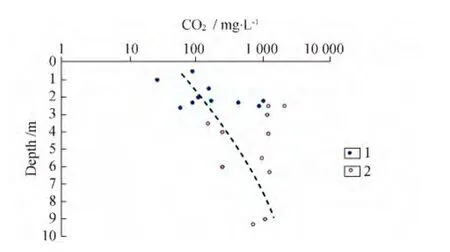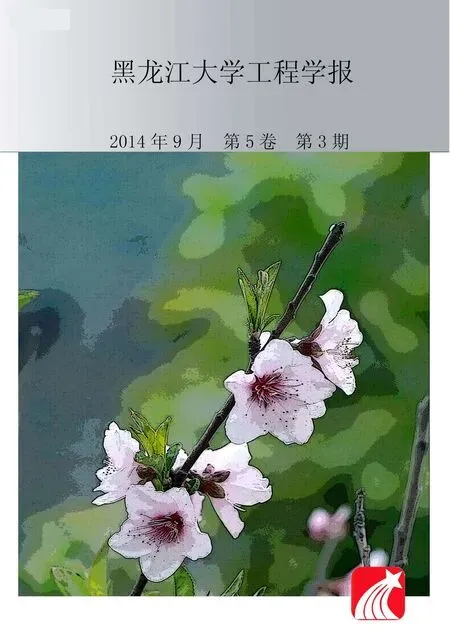雅库茨克季节性融化和冻结的侵蚀特征
Torgovkin N.V.,Makarov V.N.
(俄罗斯科学院西伯利亚分院麦尔尼科夫冻土研究所,雅库茨克677010,俄罗斯)
0 Introduction
In engineering geology,soil aggressiveness is considered to be a negative chemical,biotic,and physicochemical influence of soils on the constructional materials of an engineering structure that leads to their destruction.The aggressiveness of wet soils depends first of all on the composition and concentration of soluble salts in them.Here,a pore solution is aggressive,and the structural destruction occurs by a mechanism of their destruction in a fluid.The two types of solution aggressiveness are most important(unfavorable)from the engineering-geological point of view:with respect to concrete(cement stone)and to metals.
There are three main types of concrete destruction (corrosion)[1].The first type includes the processes that are caused by dissolving the cement stone components.The second one involves the processes where the products that are formed during chemical interactions are either easily dissolvable and are released from concrete or are deposited as amorphous mass(carbon dioxide and magnesian aggressiveness,an impact of acidic and alkaline solutions).The third type of corrosion results from an increase in a solid phase volume,which also leads to the destruction of concrete(sulfate aggressiveness).
1 Materials and methods
To determine the degree of aggressiveness,salinity,and salt composition of seasonally thawed and permafrost soils in the city of Yakutsk,lithochemical sampling was performed for the surface area,as well as boreholes were drilled down to a depth of 10~25 m in the residential and industrial zones of the city.The chemical analyses of the soils were made at the Laboratory of Permafrost Geochemistry,Melnikov Permafrost Institute SB RAS(certificate of accreditation no.ROSS RU 0001.518584)and were analyzed by L.Yu.Boitsova,R.M.Petukhova,and O.V.Shepeleva.The influence exerted by the various types of soil aggressiveness on the different grades of concrete was studied according to SNiP 2.03.11-85“Protection of Building Structures against Corrosion”.
2 Discussion and conclusions
Unlike in the nature,salinization of soils in the city is not spread over the area.A degree of salinity of soils(depth of 0.10~0.20 m)varies in a wide range from non-saline(0.021%/100 g)to highly saline (0.98%/100 g)mainly in the old part of the city,where the large lithochemical anomalies have been formed,with the soil salinity exceeding 1%/100 g. Their chemical composition is various;salinity can be of the chloride,sulfate,or carbonate type(Fig.1).

Fig.1 The pattern for the salt composition of soils in the city of Yakutsk1-hydrocarbonates,2-sulfates,3-chlorides,4-sampling points
The soils from the active layer(depth of 2~3 m)are characterized by mainly chloride-sulfate salinity with a ratio of anions of>Cl->.A degree of salinity also varies in a wide range from non-saline (0.017%/100 g)to highly saline (0.96%/100 g).
The soil salinity decreases in the permafrost layer (depth of 5~6 m).The salt composition is dominated by hydrocarbonates and sulfates;in the urban area that was built up long time ago there are anomalies of highly saline soils with the concentration of up to 1%/100g.
Leaching aggressiveness occurs due to dissolving the calcium carbonate and washing calcium hydroxide out of concrete.All soils are aggressive to hydrocarbonate alkalinity in the territory of the city down to a depth of 10 m.A non-aggressive medium is recorded at the base of the seasonally thawed layer(STL).Table 1 presents the average indices of a change in the hydro-carbonate alkalinity for the permafrost and seasonally thawed soils with depth in the territory of Yakutsk.

Table 1 The change in the concentration of HCO3-for the permafrost and seasonally thawed soils/mg-eq
General acid type of aggressiveness is related to the content of free hydrogen ions.When a pH value is lower than 6.4(for non-retaining structures,soil hydraulic conductivity from 10 to 0.1 m/d),the medium is considered to be aggressive.In several boreholes,a pH value of the soils is 6.2~6.4;therefore,the soil water of Yakutsk exhibits general acid aggressiveness to the typical and sulfate resisting pozzolan and Portland slag cements with the smallest lateral size(thickness) of the structure less than 0.5 m(Districts A,48,50,136,and 140).If the smallest lateral size(thickness) of the structure is more than 0.5 m,the soils water is non-aggressive.
Carbon-dioxide type of aggressiveness consists in a failure of concrete as a result of calcium carbonate oxidation under the action of aggressive carbonic acid.The water is considered to be aggressive if the content of a free carbon-dioxide in the soil water exceeds the value specified in the standards.When the water-saturated soils freeze under the conditions of a hydraulically closed system,the chemical composition of the solution undergoes cryogenic metamorphization.Its mineralization considerably increases,and a ratio of the ions changes.The changes in the chemical composition are caused by the release of dissolved carbon dioxide during water crystallization.This leads to rise in carbon dioxide aggressiveness of frozen soils at a great depth (Fig.2).
Magnesian type of aggressiveness appears at the high content of magnesium ions,1 000 mg/L and over.In the territory of the city,the soils are mainly non-aggressive with respect to the content of Mg2+.

Fig.2 The change in the concentration of free CO2in suprapermafrost(1)and subpermafrost(2)waters with depth
Sulfate type of aggressiveness is recorded at the high content ofions whose limit value varies with respect to a cement grade,conditions,building structures,and concentration of Cl-.The soils that show moderate and high sulfate aggressiveness to cement are widely found in the central(“old”)part of the city,down to a depth of 10 m.The anomalously high sulfate salinity of soils is observed within the two ranges of the depths.The first one,where the concentration ofamounts to 0.8~0.9 mg-eq.,is formed at the bottom of the seasonally thawed layer within the depth ranges of 1.5~2.5 m.The second one,where the concentration ofis less and equals 0.6~0.7 mg-eq,lies at a depth of about 5 m(Fig.3).

Fig.3 The change in the concentration of sulfates in the permafrost and seasonally thawed soils with respect to depth
Chloride type of aggressiveness appears at the high content of Cl-ions whose limit value varies with respect to cement grades,conditions,a building structure,and the content.
The soils being moderately and highly chloride aggressive to cement are widely spread over the old part of the city and form a large field with an area of about 2.2 km2.The local anomalies are recorded in the southern and western parts of the city.Chloride salinity of soils with a high level of aggressiveness enters down to a depth of 6~7 m on the average,having the maximum indices at the bottom of a seasonally thawed layer,an overlying layer of frozen ground(Fig.4).

Fig.4 The change in the concentration of chlorides in the permafrost and seasonally thawed soils
A degree of an aggressive effect exerted by the media on the metal structures that are made of carbon steel depends on the chemical composition of the soil water and is estimated to be slightly and moderately aggressive according to the value of mineralization and content of chlorides and sulfates(Table 2).
Soil salinized with chlorides and sulfates of magnesium,sodium,and calcium starts freezing at a temperature of-2.3℃ at a depth of 2~5 m and-1.1℃ at a depth of 6 m.A saline soil passes from a plastic frozen to a hard frozen state at the lower temperatures.Therefore,a saline frozen soil has low strength and small values of shear strength for adfreezing to a foundation.It is characterized by an increased corrosive action on the material of foundations.

Table 2 Degree of aggressive effect exerted on the metal structures by ground water
The highly mineralized negative temperature pore solutions that are formed in the upper layer of frozen ground migrate to the deeper layers during diffusion and under the action of thermal gradient and gravitational forces.The annual occurrence of this process in the central part of Yakutsk for over 300 years led to the accumulation of chlorides,sulfates,and an increase in mineralization of a pore solution in soils and their increased aggressiveness.The water-soluble salts contained in these saline layers of frozen sands are mostly represented by sodium and magnesium chlorides;however,their concentration decreases quickly down the section at a depth in the range of 6~8 m.It is established that the greater the thickness of a layer of annual temperature variations,the deeper the migration of highly mineralized negative temperature pore solutions.The higher the salinity of frozen sands,the more unfrozen solution they contain[2],which favors the diffusion of chlorides and sulfates.
3 Conclusions
The permafrost and seasonally thawed soils in the city of Yakutsk do not exhibit leaching aggressiveness.The pore solutions in certain areas of the city where the pH values decrease to 6.2~6.4 have general acid aggressiveness to the common and sulfate resisting pozzolan and Portland slag cements with a thickness of a structure less than 0.5 m.If the lateral sizes of a struc-ture are more than 0.5 m,the soil water is non-aggressive.
The soils in the city are aggressive to hydrocarbonate alkalinity.The non-aggressive medium is recorded at the bottom of the seasonally thawed layer at a depth of about 2 m,where the indices of hydrocarbonate alkalinity exceed the norms of leaching aggressiveness of a water-medium.
The cryogenic metamorphization of the chemical composition of a solution under the conditions of a hydraulically closed system is accompanied by the release of dissolved carbon dioxide,which causes an increase in carbon dioxide aggressiveness of frozen soils at a great depth.
The seasonally thawed and permafrost soils that are characterized by high and moderate sulfate aggressiveness to Portland cement are found on the surface and are spread down to a depth of 8 m.For the sulfate resisting cement,the medium is non-aggressive in the majority of cases and is sometimes slightly aggressive.Both the thawed and frozen soils are classified as slightly and moderately aggressive to chloride aggressiveness and are found down to a depth of 6~7 m on the average and sometimes to 9 m in the old part of the city and in the lake taliks.The magnesian and acid aggressiveness of the soils is slightly manifested for the W4 grade concrete and is non-aggressive for the W6 and W8 grades.The moderately and highly aggressive soils are concentrated in the old part of the city,where the anthropogenic effect lasted for 150~200 up to 300 years.The non-aggressive and slightly aggressive soils are observed in the new districts of the city that have been under the technogenic impact for less than 80 years.As a rule,the aggressive seasonal thawed and frozen soils have high salinity of about 1%/100 g.It is recommended that the sulfate resisting cement(according to GOST 22266-76)and the W6 and W8 concrete grades should preferably be used in the districts of the city where the aggressive media are widely distributed.
[1] Moskvin V M.Corrosion of Concrete and Reinforced Concrete,Methods of Their Protection[M].Moscow:Stroiizdat,1980.
[2] Votyakov I N.Physical and Mechanical Properties of Permafrost Soils in the Central Yakutia[M].Moscow:USSR Academy of Sciences Press,1961.

